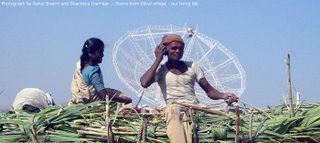The World's Indigenous Cultures

In this
fascinating video, National Geographic Explorer-in-Residence Wade Davis celebrates the extraordinary diversity of the world's indigenous cultures -- many of which are disappearing -- as ancestral land is lost and languages die. (In fact, 50 percent of the world's 6000 languages are no longer taught to children.) Against a backdrop of extraordinary photos and stories that ignite the imagination, Davis argues that we should be concerned not only for preserving the biosphere, but also the "ethnosphere", which he describes as "the sum total of all thoughts and dreams, myths, ideas, inspirations, intuitions brought into being by the human imagination since the dawn of consciousness."
Language barriers plague hospitals

Language translation becomes a question of life and death in hospitals. Read this
article from USA Today.
Many hospital patients who have a limited ability to speak English and who need a translator don't get one, which puts them at risk for poor and sometimes life-threatening medical care, an analysis in today's New England Journal of Medicine says.
[...]
Only 23% of teaching hospitals offer physicians training in how to work with an interpreter, he says. "Lack of interpreters translates into impaired health status, lower likelihood of being given a follow-up appointment, greater risk of hospital admissions and more drug complications," says Flores, a professor at the Medical College of Wisconsin-Milwaukee.
[...]
IN OTHER WORDS:
Demand surges for translators at medical facilities
Language is the soul of a culture

Language is the soul of a culture and to preserve any culture first thing we need to do is preserve the related language.
Language translation brings different cultures together. Ideas flow when literature travels from one language to another. New media has created new channels for idea flows. It provides new opportunities to let old cultures flourish.
Read about one such
struggle to save a culture by Hopis.
When will we be able to make language translation technologies inexpensive enough, simple enough and fast enough for main-stream content translation? Answer is: very soon. Langulin is a step in that direction.
Broadband for Rural India ...
... will drive thirst for content in indian languages.

From
rediff - How Anil Ambani plans to woo rural IndiaIf you thought customers in semi-urban and rural markets were using mobile phones only to make calls, think again. If Reliance Communications Ventures Ltd is to be believed, this is a myth, which has been broken.
Much to its surprise, the company realised that a sizeable portion of its customers in the towns and villages of the Bimaru (Bihar, Madhya Pradesh, Rajasthan and Uttar Pradesh) states were using cellphones to log on to the Net, stream video clippings and for infotainment.
[...]
So what is the road ahead? The company expects to invest Rs 1500 crore (Rs 15 billion) annually on broadband over the next three years. Reliance executives, however, are not willing to disclose any fresh targets.
[...]
But to cater to the rural market would need specialised content apart from the popularity of entertainment (movie clips, song downloads, etc). The company has already worked out a bevy of such services – like online price of cops in mandis, weather report at local levels and of course introduction of virtually all the regional languages to surf information.
aAqua - Translation for farmers
aAqua stands for Almost All Questions Answered. It is a multilingual online question and answer forum developed by IIT Mumbai.

It is deployed successfully in 11 kiosks covering 44 villages (supported by Ministry of Communications and IT, Development Gateway Foundation and an ICT R&D grant awarded to us by the Pan Asia group) since December 2003. The farmers of Pabal and the vicinity are aware of the aAQUA Q&A forum and have sent more than 850 questions so far with total number of posts exceeding 2000. Farmers in Pune district and around use aAQUA forums on a regular basis in aAQUA clubs. Kiosk operators charge farmers Rs 10 per query for the consultancy. Almost all of the questions have been answered in the local language (Marathi) with English answers given to people posting from outside the state. Local farmers trust the aAQUA service and are sensitive to the time it takes for the answers to arrive (current average is 1.2 days). The key to their success is that their technology enables services with people residing where they are, leveraging existing skill sets and minimizing the need of a separate team. This makes the aAQUA service scalable by stakeholders including the government, NGOs and Agri-business companies. In the current deployment farmers have to approach kiosks to send their questions. Plans for having farmers questions answered at their farm are being firmed up in Nagpur and Yeotmal Districts.
Intel and Radiant to setup 1500 internet kiosks in India
... and that translates to new windows opening up for rural India for online content. More opportunities for Langulin to provide knowledge from other languages to Indian native

languages.
Read this news from Sify.
Friday, 07 April , 2006, 08:37
Hyderabad: Radiant Infosystems Ltd has announced its tie-up with Intel Corporation to reach out its eGovernance solutions in India. The company is in the process of setting up 1,500 Internet kiosks by July end, which will serve as single-point interface to access host of government services over the Internet, besides services from private players.
Addressing a press conference here on Wednesday, the CEO of Radiant, Venu Myneni, said, "We have partnered with Intel that helps us offer their community PC platform."
The Director of Emerging Technologies, Intel Corporation, Joydeep Bose, said, "Intel actively supports efforts to provide computer technology to places where it has not previously been available."
Intel recently announced a new initiative to provide a community PC platform suitable for usage in rural areas. Such a system would be ideal for eGovernance and eLearning initiatives, Bose said.
40% of rural India may be able to come online by 2007
And this means more non-English speaking people coming online with a lot of thirst for indian language content.
Microsoft, Reliance Infocomm and kiosk agencies such as
Drishtee have reportedly chalked out plans to set up PC kiosks in Indian villages.
The government has also planned to set up 100,000 kiosks in the country’s villages by December 2007.If all goes as planned, more than 40 per cent of India’s countryside will be logged on to the Web by ‘07-end, reports
Economic Times.
At present, there are around 10,000 internet kiosks in rural India, most of which consist of ITC’s
e-Choupals.
Meanwhile, Intel has announced its Jagruti initiative in a bid to support the spread of rural internet kiosks based on the new Intel-Powered Community PCs. These PCs would be available through Intel partners HCL and Wipro.
 In this fascinating video, National Geographic Explorer-in-Residence Wade Davis celebrates the extraordinary diversity of the world's indigenous cultures -- many of which are disappearing -- as ancestral land is lost and languages die. (In fact, 50 percent of the world's 6000 languages are no longer taught to children.) Against a backdrop of extraordinary photos and stories that ignite the imagination, Davis argues that we should be concerned not only for preserving the biosphere, but also the "ethnosphere", which he describes as "the sum total of all thoughts and dreams, myths, ideas, inspirations, intuitions brought into being by the human imagination since the dawn of consciousness."
In this fascinating video, National Geographic Explorer-in-Residence Wade Davis celebrates the extraordinary diversity of the world's indigenous cultures -- many of which are disappearing -- as ancestral land is lost and languages die. (In fact, 50 percent of the world's 6000 languages are no longer taught to children.) Against a backdrop of extraordinary photos and stories that ignite the imagination, Davis argues that we should be concerned not only for preserving the biosphere, but also the "ethnosphere", which he describes as "the sum total of all thoughts and dreams, myths, ideas, inspirations, intuitions brought into being by the human imagination since the dawn of consciousness."





